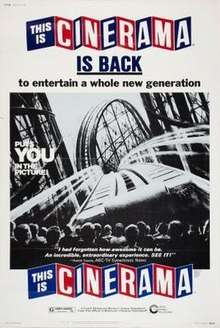This Is Cinerama
| This Is Cinerama | |
|---|---|
 | |
| Directed by | Merian C. Cooper |
| Produced by |
Robert L. Bendick Merian C. Cooper |
| Starring | Lowell Thomas |
| Music by | Miklós Rózsa |
| Cinematography | Harry Squire |
| Edited by |
William Henry Milton Shifman |
| Distributed by | Cinerama Releasing Corp. |
Release date |
|
Running time | 115 minutes |
| Country | United States |
| Language | English |
| Box office | $41.6 million [1] |
This is Cinerama is a 1952 full-length film directed by Merian C. Cooper and starring Lowell Thomas. It is designed to introduce the widescreen process Cinerama, which broadens the aspect ratio so the viewer's peripheral vision is involved. This is Cinerama premiered on September 30, 1952 at the Broadway Theatre, in New York City.
Synopsis
The film begins in black-and-white and in standard 4:3 aspect ratio, as travel writer and newscaster Lowell Thomas appears on screen to discuss the evolution of motion picture entertainment, from the earliest cave paintings designed to suggest movement, up to the introduction of color and sound. At the conclusion of the 12-minute lecture, Thomas speaks the words "This is Cinerama" and the screen expands into the full Cinerama 2.65:1 aspect ratio and color as a series of vignettes, narrated by Thomas begin.
The film includes scenes of the roller coaster from Rockaways' Playland, then moves on to a scene of the temple dance from the La Scala opera company's production of Aïda. Also seen are views of Niagara Falls; a performance by a church choir (out of pace with the rest of the film, this segment is shot in black and white); a performance by the Vienna Boys' Choir; scenes of the canals of Venice; a military tattoo in Edinburgh; a bullfight in Spain; the "Triumphal scene" from Aïda; a sound demonstration in stereo; and scenes from Cypress Gardens amusement park featuring an elaborate water skiing show.[2] The film closes with a sequence featuring soaring scenes of the natural landmarks of the American West, filmed from the nose of a low flying B-25, as the Mormon Tabernacle Choir sings "America the Beautiful", "Come, Come Ye Saints", and the "Battle Hymn of the Republic.[3]
The producers were Lowell Thomas, Merian C. Cooper, and Robert L. Bendick. The film was also directed by Bendick (and an uncredited Mike Todd, Jr.). Cooper had long experience with technical innovation in cinema, dating back to directing the original 1933 King Kong.
Production
Parts of the film were shot in the Kennecott open-pit mine and in Zion National Park in Utah.[4]
Awards
This is Cinerama was nominated for an Academy Award for Best Music, Scoring of a Dramatic or Comedy Picture. Although the score was credited to Louis Forbes, who conducted the music, it was composed by Paul Sawtell, Max Steiner (who composed the opening credit sequences, Cypress Gardens, the Flight Across America, and the End Credits) and Roy Webb.
In 2002, the Library of Congress deemed the film "culturally, historically, or aesthetically significant" and inducted it into the National Film Registry for permanent preservation.[5]
Distribution
Because the new technology required a special setup of three projectors and multiple soundtracks, the film's distribution was also revolutionary. It was shown in a single theater in most cities, with reserved seats and lengthy runs - a distribution model known as a road show.
For years the only way to see it in its entirety was in one of the three remaining 3-projector Cinerama installations that continue to preserve and show 35 mm prints. However, in September 2012, in celebration of the road show's 60th anniversary, Flicker Alley released the film in its original format, on Blu-ray.[6] The image was adjusted with the "Smilebox" format, much like the Blu-ray release of How the West was Won, and will be accompanied by an Audio Commentary and an assortment of other special features. On October 18, 2012, the Turner Classic Movies cable network aired This is Cinerama in what was announced as the first American TV broadcast of the film in its original aspect ratio (again, in the Smilebox format).
The film's copyright status is unclear. It apparently fell into the public domain in 1980, 28 years after being filed for copyright, but some allege that it was renewed, erroneously, a matter of months after this expiration.
See also
Notes
- ↑ Klady, Leonard (March 27, 1995). "Realistic Grosses". Variety. p. 10.
- ↑ Water skis were first patented by Fred Waller, the inventor of Cinerama.
- ↑ A Century of Singing, Cornwall, 1958, p. 192
- ↑ D'Arc, James V. (2010). When Hollywood came to town: a history of moviemaking in Utah (1st ed.). Layton, Utah: Gibbs Smith. ISBN 9781423605874.
- ↑ "Librarian of Congress Adds 25 Films to National Film Registry" (Press release). Library of Congress. December 17, 2002. Retrieved July 22, 2009.
- ↑ Atanasov, Svet (November 13, 2011). "This is Cinerama Blu-Ray". blu-ray.com.